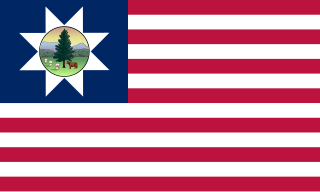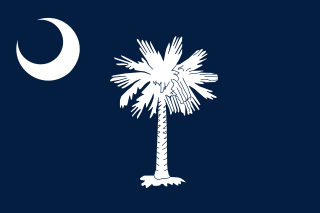The Irish Brigade was an infantry brigade, consisting predominantly of Irish Americans, who served in the Union Army in the American Civil War. The designation of the first regiment in the brigade, the 69th New York Infantry, or the "Fighting 69th," continued in later wars. The Irish Brigade was known in part for its famous war cry, the "Faugh a Ballaugh" which is an anglicization of the Irish phrase, fág an bealach, meaning "clear the way" and used in various Irish-majority military units founded due to the Irish diaspora. According to Fox's Regimental Losses, of all Union army brigades, only the 1st Vermont Brigade and Iron Brigade suffered more combat dead than the Irish Brigade during America's Civil War.

The Missouri National Guard (MONG), commonly known as the Missouri Guard, is a component of the Army National Guard and Missouri State Department of the National Guard. It is composed of Army and Air National Guard units. The Department office is located in Jefferson City.

The 69th Pennsylvania Infantry was an infantry regiment in the Union army during the American Civil War.

The 12th Vermont Infantry Regiment was a nine months' infantry regiment in the Union Army during the American Civil War. It served in the eastern theater, predominantly in the Defenses of Washington, from October 1862 to July 1863. It was a member of the 2nd Vermont Brigade.

Francis Barretto Spinola was an American politician and military leader often considered to have been the first Italian American to be elected to the United States House of Representatives, serving two terms as a representative from New York from 1887 to 1891.
The First New Jersey Brigade is the common name for an American Civil War brigade of New Jersey infantry regiments in the Union Army of the Potomac. Its official designation through most of its service was as the 1st Brigade, 1st Division, VI Corps.

Hiram Gregory Berry was an American politician and general in the Army of the Potomac during the American Civil War.

Hampton's Legion was an American Civil War military unit of the Confederate States of America, organized and partially financed by wealthy South Carolina planter Wade Hampton III. Initially composed of infantry, cavalry, and artillery battalions, elements of Hampton's Legion participated in virtually every major campaign in the Eastern Theater, from the first to the last battle.
The 5th Kentucky Infantry Regiment, unofficially known as the Louisville Legion was an infantry regiment that served in the Union Army during the American Civil War.

William Root Brewster was an officer in the Union Army during the American Civil War who commanded a regiment in the famed Excelsior Brigade of the Army of the Potomac. He later commanded the brigade, including at the Battle of Gettysburg where Brewster and his men were overrun by Confederates while defending the Emmitsburg Road position of the III Corps not far from the Peach Orchard.

The Excelsior Brigade was a military unit in the Union Army during the American Civil War. Mainly composed of infantry regiments raised in the state of New York primarily by former U.S. Representative Daniel Sickles, the brigade served in several of the Army of the Potomac's most important battles in the Eastern Theater, including Chancellorsville and Gettysburg.
Isaac Campbell Pugh was a United States volunteer soldier who was a veteran of the Black Hawk War, the Mexican–American War and the American Civil War; rising to the rank of Brevet brigadier general.

Italian Americans in the Civil War are the Italian people and people of Italian descent, living in the United States, who served and fought in the American Civil War, mostly on the side of the Union. A contingent of soldiers from the former Kingdom of the Two Sicilies fought on the Confederate side, with most of these having been former prisoners of war who had fought against Giuseppe Garibaldi during his invasion of the Two Sicilies. Between 5,000 and 10,000 Italian Americans fought in the civil war.

The 6th Regiment New York Heavy Artillery, U.S. Volunteers, the "Anthony Wayne Guard", was an artillery regiment of the Union Army during the American Civil War. It was originally mustered in as the 135th New York Volunteer Infantry Regiment, and served as both artillery and infantry.

The 99th New York Infantry Regiment, the "Union Coast Guard", "Bartlett's Naval Brigade", "Lincoln Divers", or "New York and Virginia Coast Guard", was organized as a naval infantry brigade, but mainly served as an infantry regiment of the Union Army during the American Civil War.

The 132nd New York Infantry Regiment, the "Second Regiment, Spinola's Empire Brigade"; or "Hillhouse Light Infantry", was an infantry regiment of the Union Army during the American Civil War.

The 66th New York Infantry Regiment was an infantry regiment in the Union Army during the American Civil War.

The 58th New York Infantry Regiment, also called the Polish Legion, was an infantry regiment of United States Volunteers in Union Army service during the American Civil War. The regiment was composed almost entirely of immigrant volunteers: Poles, Germans, Danes, Italians, Russians, and Frenchmen, most of whom were recruited in New York City in 1861.










